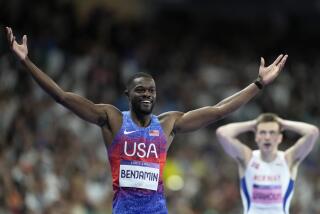‘94 Winter Olympic Games / Lillehammer : No Matter the Race, Moes Win : Skiing: His family barely arrives in time to see the U.S. downhiller’s gold-medal run.
- Share via
KVITFJELL, Norway — The race was on. It began Friday, on a mountain and in an airport. At opposite sides of the world. On snow.
In Norway, Tommy Moe licked his chops after an Olympic downhill training run here as he sized up Marc Girardelli, Kjetil Andre Aamodt and the rest.
In Alaska, father Tom and stepmother Tyra boarded a plane in Palmer.
No way dad misses the gold-medal run.
Saturday, Moe finished fourth in final downhill training and almost had to bite his lip to contain his confidence.
Andy Mill, the former downhill racer turned network commentator, tried to goad Moe into predicting victory, a la American Bill Johnson in 1984 at Sarajevo. Moe was tempted, but he wouldn’t bite.
But Moe knew.
He became only the third American male ever to win an Olympic gold medal in Alpine skiing on Sunday, defeating Aamodt by 0.04 seconds in the closest Alpine race in Olympic history.
The flight plan called for Tom and Tyra to make a leisurely connection through Kennedy airport in New York, then straight through to Oslo.
They ended up in Dallas.
Tommy checked his skis. Tom Sr. checked his pulse, then the departures.
The morning of Sunday’s downhill, as the Swiss took a few practice rings on their cowbells, Moe was almost melancholy. Someone caught him yawning.
Moe had never won a World Cup race. He was second once. What did he know?
Mr. Moe, in the meantime, was blowing fuses. There’s only so much one Moe can take.
The flight went Palmer to Dallas, Dallas to Copenhagen, Copenhagen to Oslo.
Finally, at 9:30 p.m. Saturday night, it went Oslo to Lillehammer.
Start to finish, it took 46 hours. Or was it finished? Not trusting anyone’s transportation system, Tom Moe awoke at 5 a.m. to catch the first bus to Kvitfjell, usually about an hour’s trip.
At the bus stop, he and 4,000 others waited. Tom and Tyra were crushed by the humanity, shut out of one bus after another. No taxis either. Or dog sleds.
Four and a half hours after his wake-up call--90 minutes before race time--Tom and Tyra were still in Lillehammer.
“At 9:30, I was screaming mad,” Tom said. “I went into the (phone company office) and started screaming at them, anyone I could yell at, then went up and stormed past 4,000 people, they were all the way up into town.”
In one final, exasperating moment, Tom grabbed Tyra and started elbowing a path through people to the bus door.
“I was going to get there and that was it,” Tom said.
At Kvitfjell, Tommy Moe started to loosen up. He would be the eighth racer down the hill, a favorable starting position. He remained calm and collected.
“I’ve been working a lot on my mental preparation and I ski best when I’m relaxed,” Moe said later.
The bus pulled into Kvitfjell a little after 10:30. Tom and Tyra, exhausted but relieved, rushed to the entrance gate.
What could happen now?
“We couldn’t get our tickets,” Tom said. “You’d think they ought to take care of some of the parents who helped the kids here.”
Two minutes before Luxembourg’s Girardelli left the downhill starting gate, Tom and Tyra got their tickets and fought their way to the right side of the grandstand.
Not quite box seats.
The race was on. Girardelli set the pace with a time of 1:46:.09.
Following him down were Hannes Trinkl of Austria in 1:46.22, Peter Runggaldier of Italy in 1:46.39, Pietro Vitalini of Italy in 1:46.48 and Daniel Mahrer of Switzerland in 1:46.55.
Remarkably, the top five racers were within .46 of each other, but the times were getting slower, if only fractionally.
It appeared that Girardelli had taken the best race from the course.
Canada’s Cary Mullen, racer No. 6, then crashed after catching an edge, creating the first dramatic pause of the Olympics.
As officials tended to Mullen, who was not seriously injured, home-country hero Aamodt waited above in the gate, a trainer massaging his thighs, Norwegians cheering wildly and waving flags down in the basin.
Mullen finally cleared, Aamodt shot down the hill in a blur, the crowd becoming more frenzied whenever the scoreboard posted his intermediate times.
Aamodt was ahead at every race segment, then leaned into the wire as the new leader at 1:45.79. He got a hero’s welcome.
“When I came to the finish, I was really enjoying life,” Aamodt said. “There were 30,000 people shouting. It only lasted two minutes. Then Tommy came down.”
Moe wobbled a bit at the start and was only sixth after the first interval. Then he made up for lost time, and was in first place after the third interval as he streaked through the remaining sections, Svingen, Bukkerittet, Boygen, Loftet and Klemma.
Moe crossed at 1:45.75, four-hundredths of a second faster than Aamodt.
From his cramped position near the grandstand, Tom Moe pounded on the guard railing and implored that he be allowed across the finish area.
His son looked up at the scoreboard.
“For me, the biggest surprise was when I came down and saw my name and I was first on the board,” Moe said.
Moe still had to sweat out some big-time racers--the gold busters--among them defending Olympic champion Patrick Ortlieb of Austria and William Besse, the swift Swiss.
One after another they tried, but no one could beat Moe’s time.
There were only two scares. Canada’s Ed Podivinsky, starting 21st, stopped a few hearts with his time of 1:45.87, which was good enough for the bronze medal. Then Nicolas Burtin of France, the last man Moe really feared, finished sixth on the chewed-up course, after having started 33rd.
Kyle Rasmussen, Moe’s teammate, started 26th and shot all the way to 11th.
Was the course changing? Was the track getting faster?
Moe and Aamodt, standing side by side, watched and waited.
AJ Kitt, another American of promise, posed the last real threat from the 30th position. But it soon became clear that this was not Kitt’s course, or his day. He finished 17th.
After the top 30 racers were done, Moe realized that no one from the second division could pull off a miracle. His time would hold. He would be the only American besides Johnson to have won Olympic gold in downhill.
Later, Aamodt was asked if the delay after Mullen’s crash had hurt his chances.
He jokingly replied, “I think it hurt me by about five-hundredths,” the margin separating him from the gold.
Tom Moe, draped in a conspicuous fur coat he called “a timber wolf,” was finally able to bust through security and join his son.
“I just looked at him,” Moe Sr. said. “We don’t have to say much.”
It was a different look from the one Tom Moe had flashed his son after Tommy had finished 28th in super-G in the 1992 Games in Albertville.
That look, one of disgust, had reduced Tommy to tears.
“I was so hard on him,” his father says now, remorsefully. “It made me feel like maybe (the race) was actually mine instead of Tommy’s. For this Olympics, whatever he did was fine.”
The Moes are not the Waltons. Tommy’s mother, Joann Persons, remarried after she and Tom split and is living in Whitefish, Mont. She was not here for the race.
Tommy is not John-Boy. At 13, he was caught smoking marijuana and was shipped off to live with his father in Palmer. Tom Sr. runs a river-rafting business and used to be a construction worker. Before that, he worked as a smoke jumper--”I jumped out of planes to fight fires.” Tom Sr. figured he could straighten his son out.
But Tommy loved the high life. At 16, he was caught with marijuana again and suspended from his local ski team.
“It really irritated me,” Tom Sr. said. “I thought I would do my own discipline.”
Moe took his son to work on a construction project on a barren, brutal stretch of nothingness called Dutch Harbor in the Aleutian Islands.
“Dutch Harbor is right close to hell,” Tom Sr. said after Sunday’s race.
Tommy stayed a month and a half. “I think he learned a lesson,” his father said. “He’s a skier, not a contractor.”
By all accounts, Moe has been a straight arrow since Dutch Harbor. He says his dance with drugs was all part of growing up.
“A lot of people know me as a drug user,” Tommy said at his post-race news conference. “That wasn’t true. I was just experimenting, being a normal American kid.”
And he’s come a long way from Palmer.
Late in 1992, Moe, who will turn 24 on Thursday, wanted to quit the World Cup circuit after a string of mediocre performances. He sought his father’s advice.
Unlike at Albertville, Tom Sr. was not upset with his son. He did not call him a quitter.
Instead, he extended his hand. He told his son to come home. He said he understood the strains of ski racing in Europe.
Moe went home, did some free skiing, spent time with his dad and an older brother, Mike.
Moe began the Games ranked ninth in both downhill and super-G. He has twice placed third this season in World Cup races, once in each discipline.
For this career turn, he thanks his father. “I wouldn’t have any of this if it weren’t for him, his guiding and support,” Tommy said.
“I made him tear his hair out, but he made me learn what you can have if you put your mind to something.”
Maybe it was meant to be. Although Moe deprived Aamodt and Norway of the gold, he sort of kept it in the country.
In the 1800s, Moe’s great-great-great grandfather emigrated to the United States from Oslo.
“They shouldn’t feel too bad,” Tom Moe said. “Because a Norwegian still got a medal.”
And his father got to see it.
More to Read
Go beyond the scoreboard
Get the latest on L.A.'s teams in the daily Sports Report newsletter.
You may occasionally receive promotional content from the Los Angeles Times.







